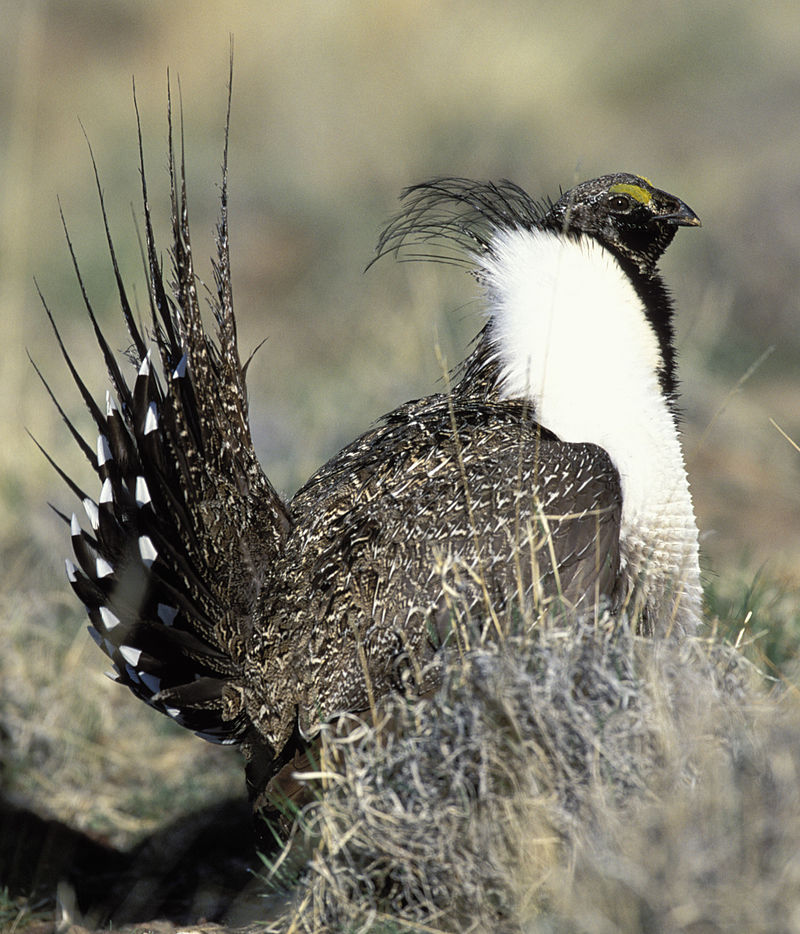
Description
Grouse are heavily built like other Galliformes, such as chickens. They range in length from 31 to 95 cm (12 to 37 in), and in weight from 0.3 to 6.5 kg (0.66 to 14.33 lb). Males are bigger than females—twice as heavy in the western capercaillie, the biggest member of the family. Grouse have feathered nostrils. Their legs are feathered to the toes, and in winter the toes, too, have feathers or small scales on the sides, an adaptation for walking on snow and burrowing into it for shelter. Unlike other Galliformes, they have no spurs.[6]Feeding and habits
These birds feed mainly on vegetation—buds, catkins, leaves, and twigs—which typically accounts for over 95% of adults' food by weight. Thus, their diets vary greatly with the seasons. Hatchlings eat mostly insects and other invertebrates, gradually reducing their proportion of animal food to adult levels. Several of the forest-living species are notable for eating large quantities of conifer needles, which most other vertebrates refuse. To digest vegetable food, grouse have big crops and gizzards, eat grit to break up food, and have long intestines with well-developed caeca in which symbiotic bacteria digest cellulose.[6]Forest species flock only in autumn and winter, though individuals tolerate each other when they meet. Prairie species are more social, and tundra species (ptarmigans, Lagopus) are the most social, forming flocks of up to 100 in winter. All grouse spend most of their time on the ground, though when alarmed, they may take off in a flurry and go into a long glide.[6]
Most species stay within their breeding range all year, but make short seasonal movements; many individuals of the ptarmigan (called rock ptarmigan in the US) and willow grouse (called willow ptarmigan in the US) migrate hundreds of kilometers.[6]
Reproduction
In all but one species (the willow ptarmigan), males are polygamous. Many species have elaborate courtship displays on the ground at dawn and dusk, which in some are given in leks. The displays feature males' brightly colored combs and in some species, brightly colored inflatable sacs on the sides of their necks. The males display their plumage, give vocalizations that vary widely between species, and may engage in other activities, such as drumming or fluttering their wings, rattling their tails, and making display flights. Occasionally, males fight.[6]The nest is a shallow depression or scrape on the ground—often in cover—with a scanty lining of plant material. The female lays one clutch, but may replace it if the eggs are lost. She begins to lay about a week after mating and lays one egg every day or two; the clutch comprises five to 12 eggs. The eggs have the shape of hen's eggs and are pale yellow, sparsely spotted with brown. On laying the second-last or last egg, the female starts 21 to 28 days of incubation. Chicks hatch in dense, yellow-brown down and leave the nest immediately. They soon develop feathers and can fly shortly before they are two weeks old. The female (and the male in the willow grouse) stays with them and protects them until their first autumn, when they reach their mature weights (except in the male capercaillies). They are sexually mature the following spring, but often do not mate until later years.[6]
Populations
A ruffed grouse in Canada
The three tundra species have maintained their former numbers. The prairie and forest species have declined greatly because of habitat loss, though popular game birds such as the red grouse and the ruffed grouse have benefited from habitat management. Most grouse species are listed by the IUCN as "least concern" or "near threatened", but the greater and lesser prairie chicken are listed as "vulnerable" and the Gunnison grouse is listed as "endangered". Some subspecies, such as Attwater's prairie chicken and the Cantabrian capercaillie, and some national and regional populations are also in danger.[6]

No comments:
Post a Comment
Note: Only a member of this blog may post a comment.